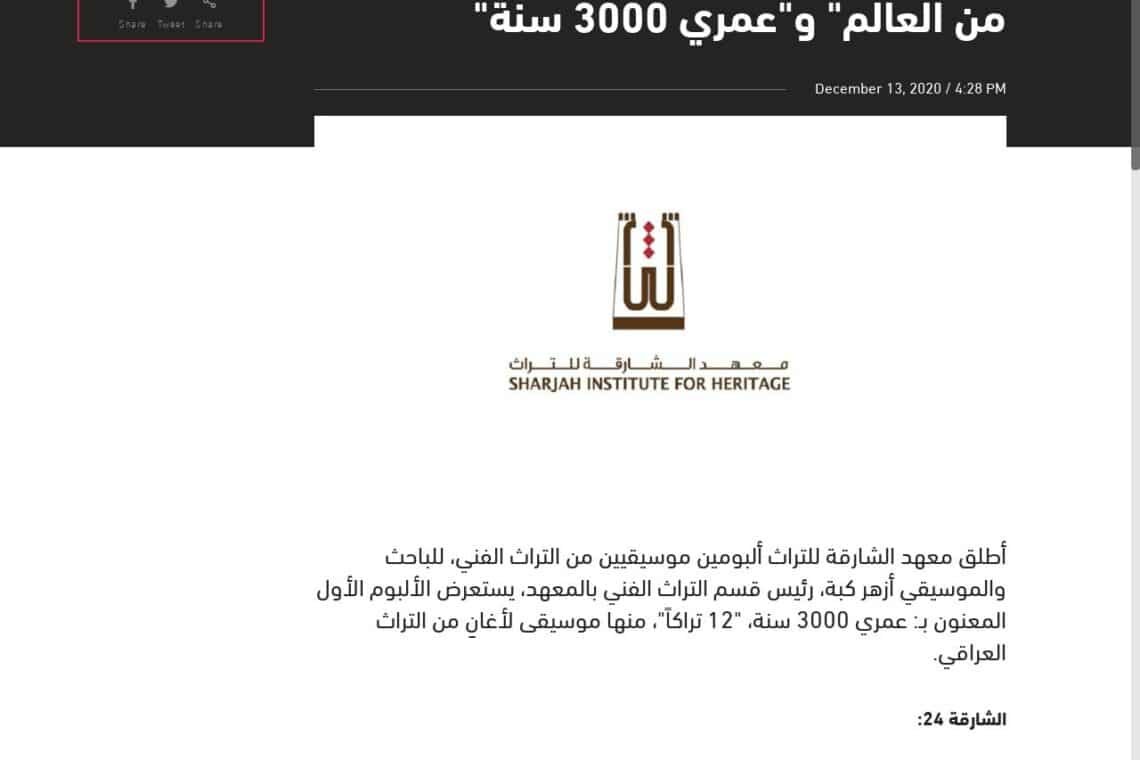
Sharjah Heritage Institute publishes & quot; folk art from the world & quot; “I am 3000 years old.”
Sharjah Heritage Institute has released two music albums from the artistic heritage, by researcher and musician Azhar Kubba, head of the artistic heritage department at the institute, reviewing the first album entitled: I am 3000 years old, “12 tracks”, including music for songs from the Iraqi heritage.
Sharjah 24:
The Sharjah Heritage Institute recently released two music albums from the artistic heritage, by researcher and musician Azhar Kubba, head of the artistic heritage department at the institute, which reviews the first album entitled: I am 3000 years old, “12 tracks”, including music for songs from the Iraqi heritage, Al-Santour translates her singing with a new distribution, as well as musical compositions, and the titles of the musical compositions are as follows: Bahida / Ad, Wana Ad, Hiyam, This Is No Equity, Memories of Baghdad, Escudara, My Journey to Andalusia, Sleeping Forbidden, Hajin Mad, Travel Paths, In addition to Music Sarah, Taqasim inspired by the Maqam al-Rast, and musical tales.
The second album includes popular arts from the world, presenting a beautiful synthesis of a group of artistic groups: Sharjah National Ensemble, Argentina, Bosnia, Croatia, Spain, Chile, Mexico, Ukraine. These arts have been documented by the folk groups that participated in the Sharjah Heritage Days during the past years, within the scope of the Institute’s wide interest in Emirati and Gulf folklore, as it is a legitimate window on the world. & nbsp;
The Iraqi artist Azhar Kubba asserted that the music of the santor contributes to the entry of the listener into the world of psychological calm, intellectual comfort, and inner peace. The beauty of its magic always inspires inner peace, as if it takes the listener to places higher than the earth and into spaces Without limits, in addition to the fact that the centaur is a difficult musical instrument to use, which led to a lack of players on it, explaining, “We need experts in the world of music.” In order to contribute to the preservation of this amazing instrument, and to protect it from extinction.
Kubba pointed out that the santor is a stringed musical instrument dating back to the first Iraqi civilizations, since the time of the Babylonians and the Sumerians, where they embodied the centaur in their historical epics, such as the Epic of Gilgamesh, which is similar to an instrument. The law, but it differs from it in the way of playing, so with the dendritic instrument the playing is performed by striking its strings with two small wooden strikes, and the sounds are switched by moving the suspenders that support the strings (usually made of wood), while the zither is played, with two blades made of silver They are worn on the index finger of the player’s right and left hands, then he taps them on the strings in front of him.
He explained that the daisy instrument contains twenty-four different notes, and they are divided and tightened in a quadrant form, so all four strings have one pitch; The number of wires or strings in a daisy is 100, with keys also numbering 100, located to the right of the instrument, and each key is divided into a string of which is designated for the tuning or tunic. To control the rhythms and vocal degrees, and the centaur plays a major role in controlling the rhythm of the song and transmitting the musical vocabulary.
And the traditional melodies of the ancient dandelion have been playing in the Arab world and the Western world, since 3000 years ago, and it is at the forefront of the ancient Iraqi instruments, and can provide unless It is presented by the former, and excel and innovate
The album was launched to reinforce the presence of the santour and his presence in the music scene, and at the same time an invitation to hear his tunes after the absence of the players of this instrument and their reluctance to present music albums based on it. And modern distribution, and innovative music, which was not previously presented so far through other traditional instruments.
This work took about a year and a half to be completed, as work was done throughout that period on the careful selection of works, re-recording, and redistribution In a more beautiful way, as music is a global language, albeit in different dialects, targeting everyone who loves life, beauty and nature, and it can be heard and understood by everyone, and students of the daisy instrument, and those who like to listen to Arabic classical music, and by the method of modern musical distribution can benefit from it.




